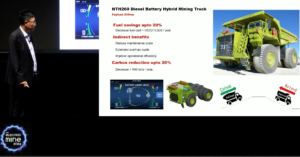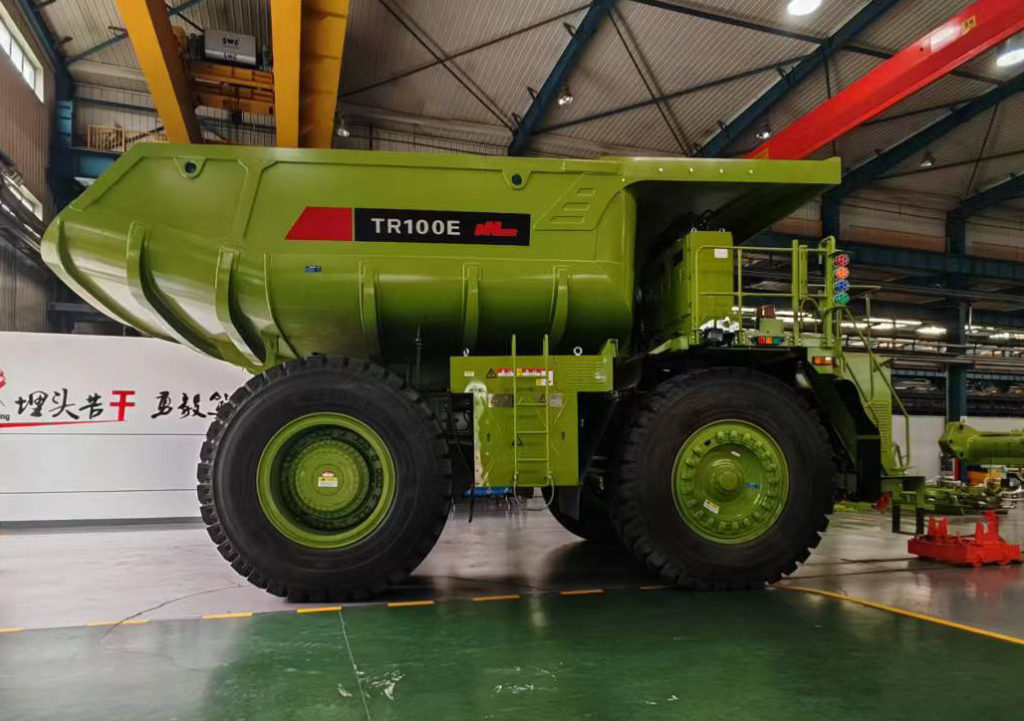At The Electric Mine 2024, Inner Mongolia North Hauler Joint Stock Co Ltd (NHL)’s Guojun Dong, its VP of Finance & Head of International Division, gave a deep dive into the Baotou-based mining truck major’s progress with new energy hauler solutions. He co-presented with Roy Zou, Group Vice President – International Division at partner Alta Technology, which manufactures traction control systems and provides electrical control systems and infrastructure for many of these new mining truck solutions; building on its wide experience in the high speed rail industry.
Dong went into some detail on NHL’s quite remarkable progress so far in supplying battery electric, hybrid and hydrogen mining trucks in China – arguably in terms of what it has actually achieved it is further ahead than any other OEM in these future technology rollouts. That this is happening in China is perhaps understandable given the vast market size – over 1,200 open pit mines in China alone. Plus it is also being driven by the ever greater government focus on greener mining.
Guojun Dong, NHL VP of Finance & Head of International Division speaking at The Electric Mine 2024

“Here is what we have done and what we have planned for the new energy. You can see up to now we already have the 50 ton, 65 ton, 100 ton and 130 ton electric trucks that have already been delivered to customers.” These are the TR50E, TR56E, TR100E and TR130E. He added that NHL sees the market as having a requirement for the TR200E and TR240E trucks and that these projects are under consideration. Today NHL works mainly with CATL for battery supply, using lithium iron phosphate chemistry, plus works primarily with Cummins on engines and Wabtec with electric wheel motors.
Looking back on its electric mining truck experience from a timeline point of view, this dates all the way back to 2013 and its delivery of six NTE330T trolley assist diesel trucks to Swakop Uranium’s Husab mine in Namibia, which are still running today. Its TR50E battery truck was developed back in 2015 and today around 100 of these are working with customer Conch Cement at its limestone mining operations with another 50 at other customer sites. NHL also built a TR65E battery truck in 2022 and the TR100E in 2023 of which 50 have now been supplied including many units to Conch Cement. The NTH35 hybrid truck was built in 2018. More than 15 NTE130E battery trucks have now also been supplied to the market and it will produce the NTE150E by end-2024. Battery trolley options are also under development.
The experience in the cement industry with the TR100E in recent years has been very positive – achieving over 110,000 t/y of production with each truck running over 16 hours operation per day and doing over 55 trips per day. Static charging takes less than 50 minutes.
Then he moved on to hybrid trucks. Interestingly it started with a very small model, the NTH35, in 2018 to prove out the technology but has followed this up with the ultraclass NTH260 which was developed in close partnership with Cummins and was recently delivered to the customer Baogang Group’s Baiyun iron mine, for trial operation. The partners are also well advanced with an NTH100E model.
He said the NTH260 (payload 236 t) with its ‘battery assist drive’ brings fuel savings of up to 20% so lowers fuel cost by over US$210,000 per year. Plus it means reduced maintenance costs, extended overhaul cycle and improved operational efficiency. Carbon reduction is up to 20% so a cut of over 540 t per year.
Next up hydrogen trucks – FCEVs. Last year a 136 t class (150 ton) NTH150 was delivered to Huolinhe coal mine. IM understands that it has been performing well – though operating hours are less than 1,000 – the issue with hydrogen trucks is the same as elsewhere in the world – related to infrastructure. There’s no cheap solution of compressed hydrogen storage at site and delivery for now, the cost of a local solution is high, so more progress will be made when the cost of compressed hydrogen is low enough for the operation. It is also not yet certain whether the Chinese market will shift towards just battery electric or also hydrogen and as such the OEMs – like NHL but also number two XCMG – are hedging their bets and offering both options.
Dong emphasised that customers in the Chinese market want a fully green ‘package’ solution and showed an interesting ecosystem graphic showing green power generation then power supplied to charging stations and onto battery trucks then an alternative of green power to hydrogen production by electrolysis of water, hydrogenation and then supply to hydrogen trucks.
On the topic of autonomy, NHL together with partners like TAGE Idriver has delivered more than 260 autonomous trucks to more than 20 open pit mining sites with a 100% repurchase rate. This includes Julong Copper, part of Zijin Mining, at over 5,455 m altitude.
A final note on the future – by the end of 2024 NHL is looking to have ready an autonomous, 136 t (150 ton) class cabless truck – the AT150 Smart Battery Truck. It will have four wheel steering, double A-arm nitrogen suspension, V2V communication, and will have dual powertrain options – a battery pack or a diesel engine. Customers in China are keen to trial the latest technologies and options so there is no shortage of mines wanting to trial the new prototype.











